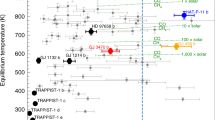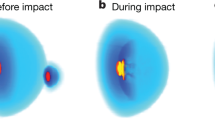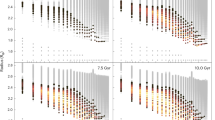Abstract
Measures of exoplanet bulk densities indicate that small exoplanets with radius less than 3 Earth radii (R⊕) range from low-density sub-Neptunes containing volatile elements1 to higher-density rocky planets with Earth-like2 or iron-rich3 (Mercury-like) compositions. Such astonishing diversity in observed small exoplanet compositions may be the product of different initial conditions of the planet-formation process or different evolutionary paths that altered the planetary properties after formation4. Planet evolution may be especially affected by either photoevaporative mass loss induced by high stellar X-ray and extreme ultraviolet (XUV) flux5 or giant impacts6. Although there is some evidence for the former7,8, there are no unambiguous findings so far about the occurrence of giant impacts in an exoplanet system. Here, we characterize the two innermost planets of the compact and near-resonant system Kepler-107 (ref. 9). We show that they have nearly identical radii (about 1.5–1.6R⊕), but the outer planet Kepler-107 c is more than twice as dense (about 12.6 g cm–3) as the innermost Kepler-107 b (about 5.3 g cm−3). In consequence, Kepler-107 c must have a larger iron core fraction than Kepler-107 b. This imbalance cannot be explained by the stellar XUV irradiation, which would conversely make the more-irradiated and less-massive planet Kepler-107 b denser than Kepler-107 c. Instead, the dissimilar densities are consistent with a giant impact event on Kepler-107 c that would have stripped off part of its silicate mantle. This hypothesis is supported by theoretical predictions from collisional mantle stripping10, which match the mass and radius of Kepler-107 c.
This is a preview of subscription content, access via your institution
Access options
Access Nature and 54 other Nature Portfolio journals
Get Nature+, our best-value online-access subscription
$29.99 / 30 days
cancel any time
Subscribe to this journal
Receive 12 digital issues and online access to articles
$119.00 per year
only $9.92 per issue
Buy this article
- Purchase on Springer Link
- Instant access to full article PDF
Prices may be subject to local taxes which are calculated during checkout



Similar content being viewed by others
Data availability
The RV data that support the findings of this study and have been used to produce some of the plots are available in the Supplementary Information. Kepler data are available at the Mikulski Archive for Space Telescopes (https://archive.stsci.edu/kepler/).
References
Lissauer, J. J. et al. All six planets known to orbit Kepler-11 have low densities. Astrophys. J. 770, 131 (2013).
Dressing, C. D. et al. The mass of Kepler-93b and the composition of terrestrial planets. Astrophys. J. 800, 135 (2015).
Santerne, A. et al. An Earth-sized planet with a Mercury-like composition. Nat. Astron. 2, 393–400 (2018).
Schlichting, H. E. in Handbook of Exoplanets (eds Deeg, H. & Belmonte, J.) 2345–2364 (Springer, Cham, 2018).
Lopez, E. D., Fortney, J. J. & Miller, N. How thermal evolution and mass-loss sculpt populations of super-Earths and sub-Neptunes: application to the Kepler-11 system and beyond. Astrophys. J. 761, 59 (2012).
Liu, S.-F., Hori, S., Lin, D. N. C. & Asphaug, E. Giant impact: an efficient mechanism for devolatilization of super-Earths. Astrophys. J. 812, 164 (2015).
Lopez, E. & Fortney, J. J. Understanding the mass-radius relation for sub-Neptunes: radius as a proxy for composition. Astrophys. J. 792, 17 (2014).
Lundkvist, M. S. et al. Hot super-Earths stripped by their host stars. Nat. Commun. 7, 11201 (2016).
Rowe, J. F. et al. Validation of Kepler’s multiple planet candidates. III. Light curve analysis and announcement of hundreds of new multi-planet systems. Astrophys. J. 784, 45 (2014).
Marcus, R. A., Sasselov, D., Hernquist, L. & Stewart, S. T. Minimum radii of super-Earths: constraints from giant impacts. Astrophys. J. Lett. 712, L73–L76 (2010).
Terquem, C. & Papaloizou, J. C. B. Migration and the formation of systems of hot super-Earths and Neptunes. Astrophys. J. 654, 1110–1120 (2007).
Van Eylen, V. & Albrecht, S. Eccentricity from transit photometry: small planets in Kepler multi-planet systems have low eccentricities. Astrophys. J. 808, 126 (2015).
Holczer, T. et al. Transit timing observations from Kepler. IX. Catalog of the full long-cadence data set. Astrophys. J. Suppl. Ser. 225, 9 (2016).
Cosentino, R. et al. HARPS-N: the new planet hunter at TNG. Proc. SPIE 8446, 84461V (2012).
Buchhave, L. A. et al. An abundance of small planets around stars with a wide range of metallicities. Nature 486, 375–377 (2012).
Silva Aguirre, V. et al. Ages and fundamental properties of Kepler exoplanet host stars from asteroseismology. Mon. Not. R. Astron. Soc. 452, 2127–2148 (2015).
Huber, D. et al. Fundamental properties of Kepler planet-candidate host stars using asteroseismology. Astrophys. J. 767, 127 (2013).
Bonomo, A. S. et al. Characterization of the planetary system Kepler-101 with HARPS-N. A hot super-Neptune with an Earth-sized low-mass companion. Astron. Astrophys. 572, A2 (2014).
Damasso, M. et al. Eyes on K2-3: a system of three likely sub-Neptunes characterized with HARPS-N and HARPS. Astron. Astrophys. 615, A69 (2018).
Zeng, L. & Sasselov, D. A detailed model grid for solid planets from 0.1 to 100 Earth masses. Publ. Astron. Soc. Pac. 125, 227 (2013).
Lopez, E. & Fortney, J. J. The role of core mass in controlling evaporation: the Kepler radius distribution and the Kepler-36 density dichotomy. Astrophys. J. 776, 2 (2013).
Leinhardt, Z. M. & Stewart, S. T. Collisions between gravity-dominated bodies. I. Outcome regimes and scaling laws. Astrophys. J. 745, 79 (2012).
Marcus, R. A., Stewart, S. T., Sasselov, D. & Hernquist, L.Collisional stripping and disruption of super-Earths. Astrophys. J. Lett. 700, L118–L122 (2009).
Chau, A., Reinhardt, C., Helled, R. & Stadel, J. Forming Mercury by giant impacts. Astrophys. J. 865, 35 (2018).
Guenther, E. W. et al. K2-106, a system containing a metal-rich planet and a planet of lower density. Astron. Astrophys. 608, A93 (2017).
Ebel, D. S. & Stewart, S. T. in Mercury: The View After MESSENGER (eds Solomon, S. C., Nittler, L. R. & Anderson, B. J.) 497–515 (Cambridge Univ. Press, Cambridge, 2018).
Benz, W., Anic, A., Horner, J. & Whitby, J. A. in Mercury (eds Balogh, A. et al.) Space Sciences Series of ISSI Vol. 26, 7–20 (Springer, New York, 2008).
Lock, S. J. et al. The origin of the Moon within a terrestrial synestia. J. Geophys. Res. 123, 910–951 (2018).
Safronov, V. S. Sizes of the largest bodies falling onto the planets during their formation. Sov. Astron. 9, 987–991 (1966).
Berger, T. A. et al. Revised radii of Kepler stars and planets using Gaia Data Release 2. Astrophys. J. 866, 99 (2018).
Jenkins, J. M. et al. Overview of the Kepler Science Processing Pipeline. Astrophys. J. Lett. 713, L87–L91 (2010).
Bonomo, A. S. et al. Detection of Neptune-size planetary candidates with CoRoT data. Comparison with the planet occurrence rate derived from Kepler. Astron. Astrophys. 547, A110 (2012).
Handberg, R. & Lund, M. N. Automated preparation of Kepler time series of planet hosts for asteroseismic analysis. Mon. Not. R. Astron. Soc. 445, 2698–2709 (2014).
García, R. A. et al. Preparation of Kepler light curves for asteroseismic analyses. Mon. Not. R. Astron. Soc. 414, L6–L10 (2011).
Kjeldsen, H. & Frandsen, S. High-precision time-resolved CCD photometry. Publ. Astron. Soc. Pacif. 104, 413–434 (1992).
Handberg, R. & Campante, T. L. Bayesian peak-bagging of solar-like oscillators using MCMC: a comprehensive guide. Astron. Astrophys. 527, A56 (2011).
Lund, M. N. et al. Standing on the shoulders of dwarfs: the Kepler Asteroseismic LEGACY Sample. I. Oscillation mode parameters. Astrophys. J. 835, 172 (2017).
Corsaro, E. & De Ridder, J. DIAMONDS: a new Bayesian nested sampling tool. Application to peak bagging of solar-like oscillations. Astron. Astrophys. 571, A71 (2014).
White, T. R. et al. Asteroseismic diagrams from a survey of solar-like oscillations with Kepler. Astrophys. J. Lett. 742, L3 (2011).
Davies, G. R. et al. Oscillation frequencies for 35 Kepler solar-type planet-hosting stars using Bayesian techniques and machine learning. Mon. Not. R. Astron. Soc. 456, 2183–2195 (2016).
Mortier, A. et al. Correcting the spectroscopic surface gravity using transits and asteroseismology. No significant effect on temperatures or metallicities with ARES and MOOG in local thermodynamic equilibrium. Astron. Astrophys. 572, A95 (2014).
Mortier, A. et al. New and updated stellar parameters for 90 transit hosts. The effect of the surface gravity. Astron. Astrophys. 558, A106 (2013).
Asplund, M., Grevesse, N., Sauval, A. J. & Scott, P. The chemical composition of the Sun. Annu. Rev. Astron. Astrophys. 47, 481–522 (2009).
Weiss, A. & Schlattl, H. GARSTEC—the Garching Stellar Evolution Code. The direct descendant of the legendary Kippenhahn code. Astrophys. Space Sci. 316, 99–106 (2008).
Christensen-Dalsgaard, J. ADIPLS—the Aarhus adiabatic oscillation package. Astrophys. Space Sci. 316, 113–120 (2008).
Thoul, A. A., Bahcall, J. N. & Loeb, A. Element diffusion in the solar interior. Astrophys. J. 421, 828–842 (1994).
Freytag, B., Ludwig, H.-G. & Steffen, M. Hydrodynamical models of stellar convection. The role of overshoot in DA white dwarfs, A-type stars, and the Sun. Astron. Astrophys. 313, 497–516 (1996).
Kjeldsen, H., Bedding, T. R. & Christensen-Dalsgaard, J. Correcting stellar oscillation frequencies for near-surface effects. Astrophys. J. Lett. 683, L175 (2008).
Silva Aguirre, V. et al. Stellar ages and convective cores in field main-sequence stars: first asteroseismic application to two Kepler targets. Astrophys. J. 769, 141 (2013).
Pepe, F. et al. The CORALIE survey for southern extra-solar planets VII. Two short-period Saturnian companions to HD 108147 and HD 168746. Astron. Astrophys. 388, 632–638 (2002).
Malavolta, L. et al. The Kepler-19 system: a thick-envelope super-Earth with two Neptune-mass companions characterized using radial velocities and transit timing variations. Astron. J. 153, 224 (2017).
Boisse, I. et al. Disentangling between stellar activity and planetary transits. Astron. Astrophys. 528, A4 (2011).
Noyes, R. W., Hartmann, L. W., Baliunas, S. L., Duncan, D. K. & Vaughan, A. H. Rotation, convection, and magnetic activity in lower main-sequence stars. Astrophys. J. 279, 763–777 (1984).
Zechmeister, M. & Kürster, M. The generalised Lomb-Scargle periodogram. A new formalism for the floating-mean and Keplerian periodograms. Astron. Astrophys. 496, 577–584 (2009).
Gregory, P. C. A Bayesian analysis of extrasolar planet data for HD 73526. Astrophys. J. 631, 1198–1214 (2005).
Matsumura, S., Takeda, G. & Rasio, F. A. On the origins of eccentric close-in planets. Astrophys. J. Lett. 686, L29 (2008).
Lainey, V. Quantification of tidal parameters from Solar System data. Celest. Mech. Dyn. Astr. 126, 145–156 (2016).
Chambers, J. E. A hybrid symplectic integrator that permits close encounters between massive bodies. Mon. Not. R. Astron. Soc. 304, 793–799 (1999).
Eastman, J., Gaudi, B. S. & Agol, E. EXOFAST: a fast exoplanetary fitting suite in IDL. Publ. Astron. Soc.Pacif. 125, 83 (2013).
Haywood, R. et al. Planets and stellar activity: hide and seek in the CoRoT-7 system. Mon. Not. R. Astron. Soc. 443, 2517–2531 (2014).
Feroz, F., Hobson, M. P., Cameron, E. & Pettitt, A. N. Importance nested sampling and the MultiNest algorithm. Preprint at https://arxiv.org/abs/1306.2144 (2014).
Buchner, J. et al. X-ray spectral modelling of the AGN obscuring region in the CDFS: Bayesian model selection and catalogue. Astron. Astrophys. 564, A125 (2014).
Kass, R. E. & Raftery, A. E. Bayes factors. J. Am. Stat. Assoc. 90, 773–795 (1995).
Xie, J.-W. et al. Exoplanet orbital eccentricities derived from LAMOST-Kepler analysis. Proc. Natl Acad. Sci. USA 113, 11431–11435 (2016).
Borsato, L. et al. TRADES: a new software to derive orbital parameters from observed transit times and radial velocities. Revisiting Kepler-11 and Kepler-9. Astron. Astrophys. 571, A38 (2014).
Bonomo, A. S. et al. Improved parameters of seven Kepler giant companions characterized with SOPHIE and HARPS-N. Astron. Astrophys. 575, A85 (2015).
Mandel, K. & Agol, E. Analytic light curves for planetary transit searches. Astrophys. J. 580, L171–L175 (2002).
Kipping, D. Efficient, uninformative sampling of limb darkening coefficients for two-parameter laws. Mon. Not. R. Astron. Soc. 435, 2152–2160 (2013).
Claret, A. Testing the limb-darkening coefficients measured from eclipsing binaries. Astron. Astrophys. 482, 259–266 (2008).
Fogtmann-Schulz, A. et al. Accurate parameters of the oldest known rocky-exoplanet hosting system: Kepler-10 revisited. Astrophys. J. 781, 67 (2014).
Lithwick, Y., Xie, J. & Wu, Y. Extracting planet mass and eccentricity from TTV data. Astrophys. J. 761, 122 (2012).
Mills, S. M. et al. A resonant chain of four transiting, sub-Neptune planets. Nature 533, 509–512 (2016).
Brugger, B., Mousis, O., Deleuil, M. & Deschamps, F. Constraints on super-Earth interiors from stellar abundances. Astrophys. J. 850, 93 (2017).
Grossman, L. Condensation in the primitive solar nebula. Geochim. Cosmochim. Acta 36, 597–619 (1972).
Lopez, E. D. Born dry in the photoevaporation desert: Kepler’s ultra-short-period planets formed water-poor. Mon. Not. R. Astron. Soc. 472, 245–253 (2011).
Miguel, Y., Kaltenegger, L., Fegley, B. & Schaefer, L. Compositions of hot super-Earth atmospheres: exploring Kepler candidates. Astrophys. J. Lett. 742, L19 (2011).
Kite, E. S., Fegley, B. Jr, Schaefer, L. & Gaidos, E. Atmosphere-interior exchange on hot, rocky exoplanets. Astrophys. J. 828, 80 (2016).
Schlichting, H. E., Sari, R. & Yalinewich, A. Atmospheric mass loss during planet formation: the importance of planetesimal impacts. Icarus 247, 81–94 (2015).
Zahnle, K. J. & Catling, D. C. The cosmic shoreline: the evidence that escape determines which planets have atmospheres, and what this may mean for Proxima Centauri B. Astrophys. J. 828, 80 (2017).
Springel, V. The cosmological simulation code GADGET-2. Mon. Not. R. Astron. Soc. 364, 1105–1134 (2005).
Ćuk, M. & Stewart, S. T. Making the moon from a fast-spinning Earth: a giant impact followed by resonant despinning. Science 338, 1047–1052 (2012).
Valencia, D., O’Connell, R. J. & Sasselov, D. Internal structure of massive terrestrial planets. Icarus 181, 545–555 (2006).
Benz, W. & Asphaug, E. Catastrophic disruptions revisited. Icarus 142, 5–20 (1999).
Acknowledgements
The authors wish to thank R. D. Haywood, R. Silvotti and D. Charbonneau for useful discussions. The HARPS-N project was funded by the Prodex Program of the Swiss Space Office (SSO), the Harvard-University Origin of Life Initiative (HUOLI), the Scottish Universities Physics Alliance (SUPA), the University of Geneva, the Smithsonian Astrophysical Observatory (SAO), the Italian National Astrophysical Institute (INAF), University of St. Andrews, Queen’s University Belfast and University of Edinburgh. The present work is based on observations made with the Italian Telescopio Nazionale Galileo (TNG) operated on the island of La Palma by the Fundación Galileo Galilei of the INAF (Istituto Nazionale di AstroFisica) at the Spanish Observatorio del Roque de los Muchachos of the Instituto de Astrofísica de Canarias. This paper exploited data collected by the Kepler mission; funding for the Kepler mission is provided by the NASA (National Aeronautics and Space Administration) Science Mission directorate. The research leading to these results received funding from the European Union Seventh Framework Programme (FP7/2007–2013) under grant agreement number 313014 (ETAEARTH). L.Z. acknowledges support from the Simons Foundation (SCOL (award no. 337090)). M.D. acknowledges financial support from Progetto Premiale 2015 FRONTIERA funding scheme of the Italian Ministry of Education, University, and Research. Funding for the Stellar Astrophysics Centre is provided by The Danish National Research Foundation (grant agreement no. DNRF106). V.S.A. acknowledges support from VILLUM FONDEN (research grant 10118). E.C. is funded by the European Union’s Horizon 2020 research and innovation program under the Marie Sklodowska-Curie grant agreement no. 664931. T.D. is supported by a STFC PhD studentship. R.A.G. acknowledges support from CNES. This work has been carried out in the frame of the National Centre for Competence in Research PlanetS supported by the Swiss National Science Foundation (SNSF). C.L., F.B., F.P. and S.U. acknowledge the financial support of the SNSF. M.S.L. is supported by The Independent Research Fund Denmark’s Sapere Aude program (grant agreement no. DFF–5051–00130). S.M. acknowledges support from the Ramon y Cajal fellowship number RYC-2015–17697.
Author information
Authors and Affiliations
Contributions
The underlying radial-velocity observation programme was conceived and organized by F.P., A.C.C., D.W.L., C.L., D.Ségransan, S.U. and E.M. Observations with HARPS-N were carried out by L.A., A.C.C., A.M., C.D.D., M.D., X.D., R.C., A.F.M.F., P.F., A.H., F.M., M.L.-M., L.M., C.N., V.N., K.R. and A.V. C.L. maintained and updated the reduction pipeline, L.M. implemented the correction of radial velocities for moonlight contamination, and X.D. computed the values of the log(R’HK) activity indicator. A.S.B., M.D. and K.R. analysed and modelled the radial velocities. L.M. simulated and compared the radial velocities using both non-interacting and interacting Keplerians. A.S.B. also performed the transit fitting and S.M.M. worked on the analysis of transit timing variations. A.S.B. and A.V. analysed the Kepler light curve in search of the stellar rotational modulation signal. L.B. and A.M. determined the stellar atmospheric parameters from the HARPS-N spectra; A.M. also derived the stellar chemical abundances. T.A., M.B., E.C., J.C.-D., R.A.G., R.H., A.B.J., H.K., M.N.L., M.S.L., S.M. and V.S.A. carried out the asteroseismic analysis of the Kepler light curve and determined the stellar parameters from which A.S.B. and M.D. derived the planetary orbital and physical parameters. L.Z. deduced the planet interior compositions and E.L. estimated the planet atmospheric escapes. K.R. carried out dynamical simulations of the planetary system, and Z.M.L. and T.D. conducted the simulations of giant impact events. A.S.B. was the primary author of the manuscript and received important contributions by L.Z., Z.M.L., M.D., E.L., M.N.L., V.S.A., A.S., A.M. and M.L.-M. All authors have contributed to the interpretation of the data and the results.
Corresponding author
Ethics declarations
Competing interests
The authors declare no competing interests.
Additional information
Publisher’s note: Springer Nature remains neutral with regard to jurisdictional claims in published maps and institutional affiliations.
Supplementary information
Supplementary Information
Supplementary Figures 1–8, Supplementary Tables 1–4.
Rights and permissions
About this article
Cite this article
Bonomo, A.S., Zeng, L., Damasso, M. et al. A giant impact as the likely origin of different twins in the Kepler-107 exoplanet system. Nat Astron 3, 416–423 (2019). https://doi.org/10.1038/s41550-018-0684-9
Received:
Accepted:
Published:
Issue Date:
DOI: https://doi.org/10.1038/s41550-018-0684-9
This article is cited by
-
Large planets may not form fractionally large moons
Nature Communications (2022)
-
The Exosphere as a Boundary: Origin and Evolution of Airless Bodies in the Inner Solar System and Beyond Including Planets with Silicate Atmospheres
Space Science Reviews (2022)
-
Terrestrial planet compositions controlled by accretion disk magnetic field
Progress in Earth and Planetary Science (2021)
-
Loss and Fractionation of Noble Gas Isotopes and Moderately Volatile Elements from Planetary Embryos and Early Venus, Earth and Mars
Space Science Reviews (2020)
-
Future Missions Related to the Determination of the Elemental and Isotopic Composition of Earth, Moon and the Terrestrial Planets
Space Science Reviews (2020)



